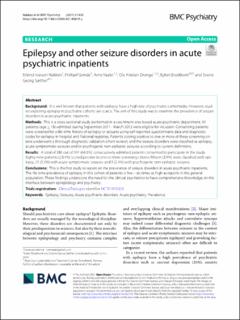| dc.contributor.author | Nakken, Erlend Iversen | |
| dc.contributor.author | Grinde, Frithjof | |
| dc.contributor.author | Vaaler, Arne | |
| dc.contributor.author | Drange, Ole Kristian | |
| dc.contributor.author | Brodtkorb, Eylert | |
| dc.contributor.author | Sæther, Sverre Georg | |
| dc.date.accessioned | 2022-03-28T12:02:42Z | |
| dc.date.available | 2022-03-28T12:02:42Z | |
| dc.date.created | 2022-01-09T21:08:15Z | |
| dc.date.issued | 2021 | |
| dc.identifier.citation | BMC Psychiatry. 2021, 21 (1), . | en_US |
| dc.identifier.issn | 1471-244X | |
| dc.identifier.uri | https://hdl.handle.net/11250/2988016 | |
| dc.description.abstract | Background: It is well known that patients with epilepsy have a high rate of psychiatric comorbidity. However, studies exploring epilepsy in psychiatric cohorts are scarce. The aim of this study was to examine the prevalence of seizure disorders in acute psychiatric inpatients. Methods: This is a cross-sectional study performed in a catchment-area based acute psychiatric department. All patients (age > 18) admitted during September 2011 - March 2012 were eligible for inclusion. Consenting patients were screened for a life-time history of epilepsy or seizures using self-reported questionnaire data and diagnostic codes for epilepsy in hospital and National registries. Patients scoring positive to one or more of these screening criteria underwent a thorough diagnostic validation (chart review), and the seizure disorders were classified as epilepsy, acute symptomatic seizures and/or psychogenic non-epileptic seizures according to current definitions. Results: A total of 380 out of 591 (64.3%) consecutively admitted patients consented to participate in the study. Eighty-nine patients (23.4%) scored positive to one or more screening criteria. Fifteen (3.9%) were classified with epilepsy, 21 (5.5%) with acute symptomatic seizures and 9 (2.4%) with psychogenic non-epileptic seizures. Conclusions: This is the first study to report on the prevalence of seizure disorders in acute psychiatric inpatients. The life-time prevalence of epilepsy in this cohort of patients is five - six times as high as reports in the general population. These findings underscore the need for the clinical psychiatrist to have comprehensive knowledge on the interface between epileptology and psychiatry. Trials registration: ClinicalTrials.gov identifier NCT01415323. | en_US |
| dc.language.iso | eng | en_US |
| dc.publisher | BMC | en_US |
| dc.rights | Navngivelse 4.0 Internasjonal | * |
| dc.rights.uri | http://creativecommons.org/licenses/by/4.0/deed.no | * |
| dc.title | Epilepsy and other seizure disorders in acute psychiatric inpatients | en_US |
| dc.type | Peer reviewed | en_US |
| dc.type | Journal article | en_US |
| dc.description.version | publishedVersion | en_US |
| dc.source.pagenumber | 0 | en_US |
| dc.source.volume | 21 | en_US |
| dc.source.journal | BMC Psychiatry | en_US |
| dc.source.issue | 1 | en_US |
| dc.identifier.doi | 10.1186/s12888-021-03619-y | |
| dc.identifier.cristin | 1977109 | |
| cristin.ispublished | true | |
| cristin.fulltext | original | |
| cristin.qualitycode | 2 | |

